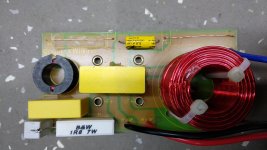It is said that too much stuffing or fill can sound just as bad as not enough. Is it lower bass only, upper bass and mids only? Also, did you try a BSC circuit? Various values of resistors in parallel with the woofer inductor to adjust the "tilt" of the low pass roll off? If padding down the tweeter works and the tonal balance is good, maybe that was what was needed only? Lots of things to try; I am just now having my first coffee and haven't read through all the previous posts so I am unsure what has already been attempted and in what order. I'm sure others can offer suggestions here as well. Of course; you can always try to make accurate measurements but do so with the enclosures in their intended and final listening location. The room size and shape plus placement have a GREAT deal to do with the over all tonal balance, bass room gain, etc.
Maybe you'd like to share your crossover circuit here? A 8"- 1" speaker has a certain sound, even with the crossover optimized.After a few hours of listening I notice a lack of mid / bass, the tweeter had to cut 2dbs.
My apology if my question is too redundant. I like the grain on the baffle material, open with nice patterning. My guess it will take different stains well.
What species is that?
What species is that?
what I miss is more of the mids, but I already solved part I lowered the crossover point of the tweeter to 2kz. the crossover is 1st order a 2.2mh coil for the woofer and now 10uf for the tweeter
Sometimes if I have a 1st order LP on the woofer without out quite enough mids; I 1) put a resistor in parallel with the inductor to make the LP roll off less than 6 dB; and 2) try 2nd order but raise the frequency. Some larger woofers can go higher than 2 KHz but not many do it well. With option 2), you actually boost the mids but cut the treble sooner than a 1st order LP.
I just plugged in a random value in the crossover calculator; assume 8.0 Ohms, 2.2 mH the -3 dB would be about 580 Hz. If Z were 10 Ohms, F3 would be at 720 Hz; 12 Ohms, 870 Hz and so on. Do you have a good plot of the impedance curve?
For the same inductor, a BW2 would need a cap of just over 17 uF and give -3 dB at about 820 Hz. For BE2, the cap would be about 11.4 uF and give -3 dB at about 790 Hz and for LR2, the cap would be about 8.6 uF and give -3 dB at about 745 Hz. When I am unsure; I choose an inductor value that might work well at 1st order but also calculate for BE2. That way; I can try various values of capacitors above and below that closely approximate LR2, BE2 or BW2. I use cheaper budget type caps and coils until I get the desired results then upgrade to better quality caps and coils. Obviously, this is text book calculations and the real world is much more complicated, especially since most impedance curves rise with frequency and are rarely a nominal/constant value. Some drivers with very low inductance voice coils do have fairly flat impedance curves but that is not generally the norm. You can also do the same kinds of "tricks" on the tweeter high pass...1st vs 2nd order and LR2, BE2, BW2...
I just plugged in a random value in the crossover calculator; assume 8.0 Ohms, 2.2 mH the -3 dB would be about 580 Hz. If Z were 10 Ohms, F3 would be at 720 Hz; 12 Ohms, 870 Hz and so on. Do you have a good plot of the impedance curve?
For the same inductor, a BW2 would need a cap of just over 17 uF and give -3 dB at about 820 Hz. For BE2, the cap would be about 11.4 uF and give -3 dB at about 790 Hz and for LR2, the cap would be about 8.6 uF and give -3 dB at about 745 Hz. When I am unsure; I choose an inductor value that might work well at 1st order but also calculate for BE2. That way; I can try various values of capacitors above and below that closely approximate LR2, BE2 or BW2. I use cheaper budget type caps and coils until I get the desired results then upgrade to better quality caps and coils. Obviously, this is text book calculations and the real world is much more complicated, especially since most impedance curves rise with frequency and are rarely a nominal/constant value. Some drivers with very low inductance voice coils do have fairly flat impedance curves but that is not generally the norm. You can also do the same kinds of "tricks" on the tweeter high pass...1st vs 2nd order and LR2, BE2, BW2...
Little bit of crossover stuff that might help. SEAS Njord kit which must be about 3kHz crossover:
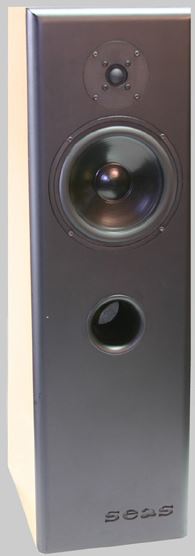
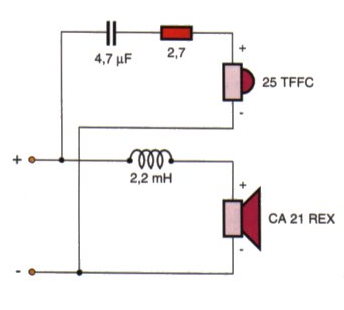
The SEAS tweeter is probably a dB louder than your Morel MDT 12. So adjust the resistor.
Another way to do things:
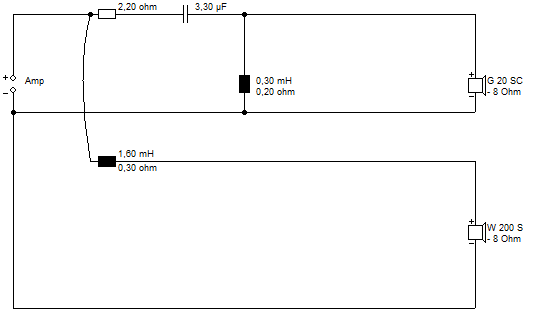
There is an issue with the hefty 1000Hz Fs of the tweeter which could be addressed with a, say, 33uF/0.7mH/2.2R Fs notch:
Morel MDT12 1" Textile Dome Tweeter
Series Notch Filter Designer / Calculator
The SEAS tweeter is probably a dB louder than your Morel MDT 12. So adjust the resistor.
Another way to do things:
There is an issue with the hefty 1000Hz Fs of the tweeter which could be addressed with a, say, 33uF/0.7mH/2.2R Fs notch:
Morel MDT12 1" Textile Dome Tweeter
Series Notch Filter Designer / Calculator
Last edited:
I don't have measurement equipment, I just listen until it is pleasant to the ear. I will try several capacitors with the 2.2mh coil. does this speaker work at 2kz? where to buy parts for the crossover in Europe?
You don't need measurement equipment with a speaker as simple as this:
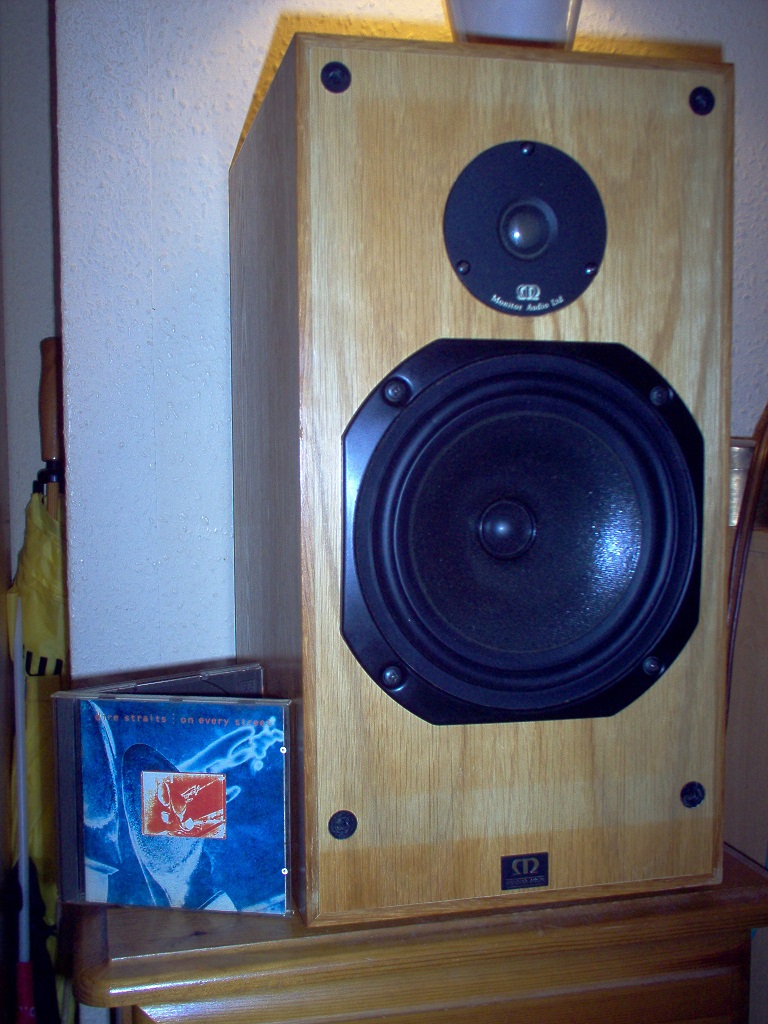
Restoring Monitor Audio R300 bookshelf speakers.
But I run a sim to learn what does what:
Software | Visaton
This is a better sort of circuit. 1st order bass with a bit of impedance correction:
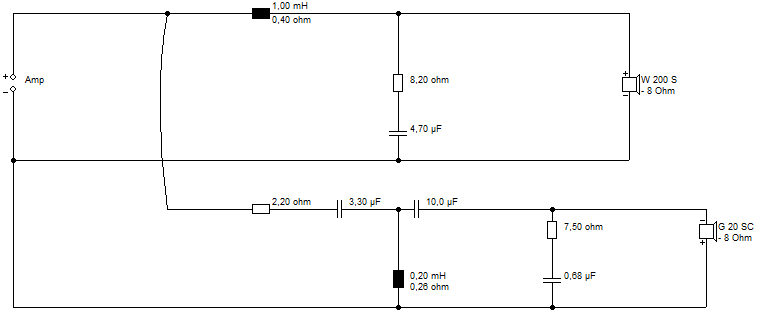
The crossover is actually 3.5kHz:
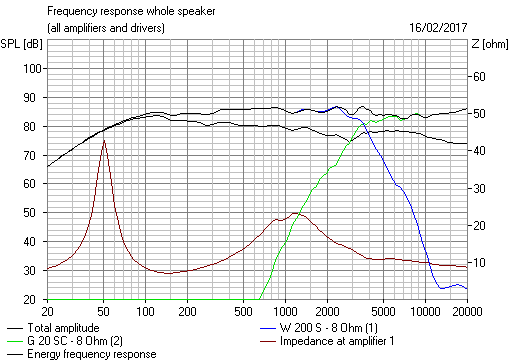
KEF did this sort of thing in the similar Celeste III:
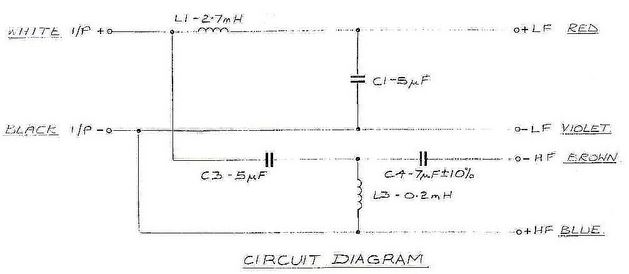
A quick Google of Capacitor + Solen, Mundorf, Alcap, Visaton or or Clarity Cap should turn up some component suppliers.
Restoring Monitor Audio R300 bookshelf speakers.
But I run a sim to learn what does what:
Software | Visaton
This is a better sort of circuit. 1st order bass with a bit of impedance correction:
The crossover is actually 3.5kHz:
KEF did this sort of thing in the similar Celeste III:
A quick Google of Capacitor + Solen, Mundorf, Alcap, Visaton or or Clarity Cap should turn up some component suppliers.
I have the B&W DM601 S3 crossover for parts and more components:
2 caps 10uf mundorf silver oil
2 caps 10uf Chinese
4 caps 2.2uf okt
2 caps 6.8uf monacor bipolar
2 caps 1.2uf 400v
2 caps 0.8uf 400v
2 coils 0.33mh
2 coils 0.19mh
2 coils 2.2mh.
What can i use to make a dicente crossover?
Thanks a lot for all helps.
2 caps 10uf mundorf silver oil
2 caps 10uf Chinese
4 caps 2.2uf okt
2 caps 6.8uf monacor bipolar
2 caps 1.2uf 400v
2 caps 0.8uf 400v
2 coils 0.33mh
2 coils 0.19mh
2 coils 2.2mh.
What can i use to make a dicente crossover?
Thanks a lot for all helps.
I have the B&W DM601 S3 crossover for parts and more components:
2 caps 10uf mundorf silver oil
2 caps 10uf Chinese
4 caps 2.2uf okt
2 caps 6.8uf monacor bipolar
2 caps 1.2uf 400v
2 caps 0.8uf 400v
2 coils 0.33mh
2 coils 0.19mh
2 coils 2.2mh.
What can i use to make a dicente crossover?
Thanks a lot for all helps.
Most of those are usable, and the circuit board, service manual here:
B&W Group North America Service & Support - Home
You will need a bigger, say 0.19mH coil on the tweeter because the B&W is a 4 ohm tweeter and maybe a bigger coil on the bass.
Notice it is negative polarity.
- Home
- Loudspeakers
- Multi-Way
- 2 way seas + morel
